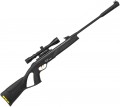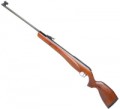Muzzle velocity
The muzzle velocity provided by the rifle - that is, the speed of the bullet as it exits the barrel.
All other things being equal, a higher bullet speed provides greater range and accuracy, and also simplifies aiming at long distances: the bullet flies along a smoother trajectory and requires fewer adjustments in height, and the influence of side winds decreases with increasing speed. On the other hand, this indicator directly affects the price of the rifle; and in some countries, legal restrictions on the ownership of pneumatic weapons are also related to the muzzle velocity of the bullet.
As for specific values, in the weakest modern rifles the initial speed does not exceed
150 m/s, and in the most powerful it can be
300 - 350 m/s or even
more(remember, the speed of sound is 330 m/s). In general, for recreational shooting at short distances, this parameter is not particularly important, and detailed recommendations for choosing pneumatics for more specific situations can be found in special sources. Let us only note that in AEG electric drives (see “Type”) the initial speed extremely rarely exceeds 150 m/s, but this is done solely for safety reasons: such “weapons” are intended for military-tactical games and initially involve shooting at people, and the high speed would be unsafe for players even with protective equipment.
It is also wor
...th considering that this indicator is not strictly defined. In any type of pneumatic it depends on the weight of the bullet (the lighter the faster); therefore, in the characteristics it is usually customary to indicate a certain average velocity for standard ammunition (usually weighing 0.5 g, in AEG - 0.2 g). In addition, in multi-compression rifles the actual speed of the bullet is determined by the degree of inflation, in gas-cylinder rifles it is determined by the ambient temperature, and in PCP models it is possible to achieve higher speeds than declared by replacing the air with a special gas (for example, helium). Nevertheless, this characteristic makes it possible to evaluate the capabilities of the rifle and compare it with other models, including those that differ in type.Muzzle energy
The muzzle energy provided by the rifle.
Muzzle energy is the kinetic energy of the bullet at the exit from the barrel. This energy, in turn, depends on two factors: the mass and the muzzle velocity of the bullet. Thus, this indicator directly describes the overall power of the rifle: higher muzzle energy allows you to effectively fire at longer distances and/or heavier ammunition. On the other hand, an increase in power accordingly affects the cost of weapons.
Note that muzzle energy can be grounds for legal restrictions on the purchase/use of pneumatics. So, in some countries in the post-Soviet space, the maximum value allowed for freely sold rifles is
7.5 J — a special permit will be required to purchase more powerful weapons. And most freely sold rifles in such regions have a power of the
order of 3 – 5 J. Such legal restrictions should be clarified separately. Lower rates are found mainly among “soft” pneumatics for airsoft (airsoft), using 6 mm plastic balls. For such models, a value of more than 2 J is already considered very solid, and in games such rifles are used with a minimum distance limit — for example, 15 m or 20 m (so that a shot from too close a distance does not injure the player).
It is also worth saying that the claimed characteristics of air rifles may, at first glance, not correspond to physical calculations. For example, for a model for the same 7.5 J
..., the initial speed of 250 m/s can be claimed in the characteristics; for a 4.5 mm bullet weighing 0.5 g (the average, most popular weight), this would correspond to an energy of as much as 15.6 J. However, there are no inconsistencies here: such characteristics mean that the muzzle velocity was measured for a lighter bullet (for example, 0 .2 g), which accelerates more strongly at the outlet of the barrel. Accordingly, with heavier ammunition, the speed will be lower; it can be determined using special formulas or online calculators.Cheek adjustment
The ability to adjust the location of the emphasis under the cheek, located on the butt. Usually, we are talking about at least height adjustment, and in advanced models it may also be possible to move the stop back and forth. Anyway, this feature allows you to adjust the position of the cheek to the physique and personal preferences of a particular shooter, thus providing the most comfortable tab — and this convenience, in turn, has a positive effect on accuracy. At the same time, the ability to
adjust the cheekpiece significantly increases the price of the rifle, and therefore it is found mainly in top-class models.
Magnification
The degree of magnification provided by the rifle's complete optical sight; for models with variable magnification, the entire adjustment range is indicated, for example 3 – 9x.
For sights of this type in general, see "Aiming Device". And several points depend on the degree of increase at once. On the one hand, a higher magnification allows you to better see small and/or distant targets and facilitates high-precision shooting; on the other hand, it limits the angle of view and significantly affects the cost of the sight, and sometimes also its dimensions and weight. And since air rifles are mostly not designed for long distances, the magnification of complete optics in them usually does not exceed 9x, and one of the most popular options is 4x. However, there are exceptions: in powerful high-end pneumatics, you can find sights with a maximum magnification of 24x and even higher.
Actually, the manufacturer most often selects the magnification of optics for the ballistic characteristics of the rifle. So, when choosing this parameter, it often turns out to be secondary, and it makes sense to focus primarily on the muzzle velocity of the bullet and the firing range for which the weapon is designed — usually, the capabilities of complete optics are quite enough for this. It is also worth mentioning the variable magnification sights mentioned at the beginning, which are quite common nowadays — they are somewhat more complicated and more expensive than fix...ed optics, but they allow you to adjust the magnification to the specifics of the situation.
Lens diameter
The diameter of the front lens (objective) in the optical sight, which is equipped with a rifle.
For sights of this type in general, see "Aiming Device". And the diameter of the lens depends primarily on the amount of light entering the scope. Thus, other things being equal, a larger front lens produces a clearer and brighter image; this is especially noticeable in low light. On the other hand, a larger lens is noticeably more expensive, and it also affects the weight and dimensions of the sight; and in bright daylight, the difference from the “smaller” optics may not be fundamental. In addition, recall that the actual image quality is determined by a number of other factors; as a result, high-end optics with a relatively small front lens may well be more effective than a large low-cost model.
In view of the foregoing, it is worth paying attention to the diameter of the lens in cases where the sight is planned to be used in low light conditions — in a dense forest, at dusk, etc. In this case, it is worth considering not only this indicator, but also other features of the optics (and it is best to focus on practical reviews). If the rifle is bought for recreational use in the daytime in good light, the size of the lens will be a purely reference parameter: in such conditions, almost any optical sight works normally.
Barrel length
The working length of the rifle barrel is from the chamber where the bullet is loaded to the muzzle. The shortest barrels found nowadays have a length
of just over 200 mm(and in some AEGs even
less than this value); the longest reach
500 – 600 mm.
There is a stereotype that the muzzle velocity directly depends on the length of the barrel. In firearms, this is true — but not in pneumatics. Firstly, in such rifles, the initial velocity depends on a number of other indicators — pressure, the quality of the barrel treatment, the efficiency of the valves, etc. on the first 20 – 25 cm of the barrel, then the gas pressure drops noticeably. The exception is PCP rifles, in which the longer barrel really makes it easier to achieve high speeds. However, again, so many additional factors affect the final result that models with the same barrel length can differ markedly in initial speed.
The second common stereotype is that a longer barrel improves accuracy and accuracy. This is true in the context that a longer barrel allows for a greater distance between the front and rear sights, making it easier to aim carefully. Technical accuracy does not depend on the length, but on the quality of the barrel processing.
Summing up all of the above, we can say that the length of the barrel for an air rifle is more of a reference than a really significant paramete
...r, and when choosing, it is better to focus on more "close to life" characteristics — first of all, directly claimed muzzle velocity.Stock material
—
Tree. A classic material used in firearms and then pneumatic weapons since ancient times (in fact, since its inception). Wooden stocks are strong enough on their own, and in modern rifles they are also amenable to special treatment to protect against dampness, temperature changes, etc .; while the rifles have a nice appearance in a classic style. At the same time, the wood is prone to abrasion, scratches easily appear on it, and there is a possibility of cracks. When used in simple conditions, such as periodic "shooting" in the country, this does not matter, however, for example, a wooden stock is not suitable for hunting — at least because it will quickly lose its "presentation". At the same time, this material is also somewhat more expensive and more difficult to process than plastic that is more resistant to “troubles”. Therefore, today the tree is used mainly in pneumatics of the middle and upper price range and is designed for those who are primarily interested in the aesthetics of weapons.
—
Plastic. One of the most popular materials for the manufacture of modern pneumatics. Such stocks are easy to manufacture and inexpensive, while the plastic can be given a rather complex shape without any problems, which, in particular, facilitates the installation of various adjustment systems (see “Cheek Adjustment”, “Butt / Stock Adjustment”). However, its main advantage is practicality: this materia
...l is resistant to impacts, cracks and scratches, comparable in strength to wood (or even superior) and has a small weight. As a result, plastic has become widespread in almost all price ranges.
— Aluminium. A fairly advanced material that combines low weight and high strength. On the other hand, aluminium stocks for classic pneumatics are generally expensive, and therefore are used mainly in high-end professional models (although there are exceptions). But in airsoft rifles that copy real weapons, the situation is somewhat different: there aluminium can be used as a simpler and more affordable alternative to steel (from which gunshot prototypes are made).
